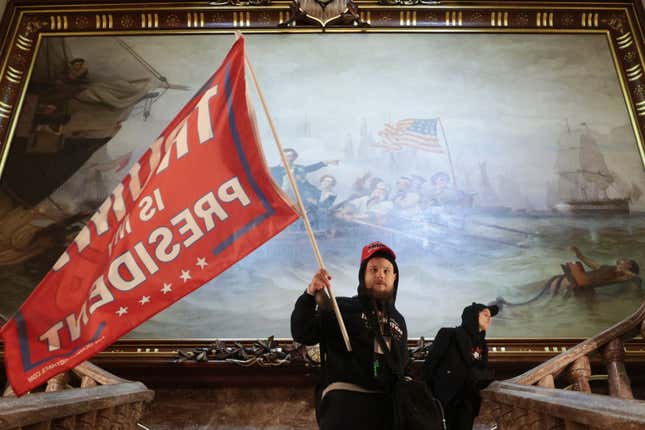
Image: Win McNamee
The photograph is arresting: a bearded man stands at the top of a staircase located in the Senate wing of the Capitol bearing uniquely American symbols, marking both time and ideology. He holds in his right hand a red flag with the phrase “Trump is my president” written across it in bold white lettering. He wears a red hat on his head, close in design to the now ubiquitous MAGA hat, an accessory that, perhaps more so than any other political ephemera, quickly and completely signifies the personality and beliefs of its wearer. He stands in front of William Henry Powell’s Battle of Lake Erie (1873), a large canvas that depicts Oliver Hazard Perry’s mythic luck and heroic endurance during an American victory in the War of 1812. In the frame of this photograph are two images, one historic one contemporary, depicting stories of origins and conclusions: the emergence of the United States as a fully independent state following the culmination of tensions with the United Kingdom contrasted with the inevitable culmination of four years of violent rhetoric and the origin of a new political identity. Here, in this photograph taken by Getty’s Win McNamee, the elaborate gilded frame of Powell’s canvas seems to absorb the man, making him part of the painting, part of what it represents by nature of both subject and location. Here too is a contrast of heroic gestures that history-making demands: Perry stands tall in his rowboat, pointing decisively to his final destination (a gesture taken from the history of art but, no doubt, meant to conjure up Emanuel Leutz’s Washington Crossing the Delaware) while the rioter waves his flag—echoing the American flag in Powell’s painting—not in surrender but in advance, signaling to his compatriots.
Here is pure spectacle, not just an accumulation of images, but politics mediated solely by images and the desire to make them real. This was, in many ways, inevitable. Since its very beginning, the Trump administration has reveled in images, making them the very backbone of its ideology. Walter Benjamin, of course, very famously described “the introduction of aesthetics into political life” as the “backbone” of fascism. The fascist aesthetic, which reached its apotheosis last week in a coup that’s very point seemed to be the production and dissemination of photographs (indeed, there were even costumes). If Perry had Powell and Washington had Leutz to transform them into founding myths, the Capitol rioters had the camera. But the camera, and the expression that it emboldens, has really always been Trump’s promise to his most faithful. “Fascism,” Benjamin wrote, “sees its salvation in giving the masses not their right, but instead a chance to express themselves.”
And the expression of anger, of whiteness, of xenophobia, nationalism, and even social identity is what Trump gave those who voted for him. He did it insistently and consistently throughout his entire presidency. He played to their perceived political humiliation, promising to make them heroes. “Everybody is educated to become a hero,” Umberto Eco wrote in 1995, as he sketched the basic tenets of what he called “Ur-Fascism,” remembering his own childhood in Mussolini’s Italy. “In every mythology the hero is an exceptional being,” Eco noted, “heroism is the norm.”
-

-

-

-

-

-

-

-

-

-

-

-

-

-

-

-

-

-

-

-

-

-

-

-

-

-

-

-

-

-

-

-

-

-

-

-

-

-

-

-








































